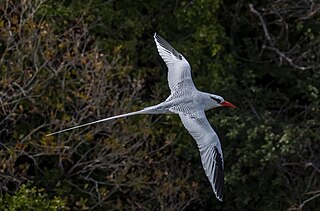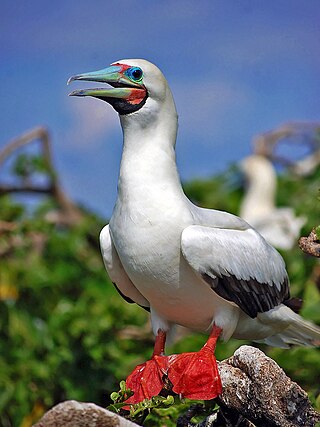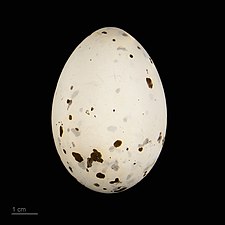
Tropicbirds are a family, Phaethontidae, of tropical pelagic seabirds. They are the sole living representatives of the order Phaethontiformes. For many years they were considered part of the Pelecaniformes, but genetics indicates they are most closely related to the Eurypygiformes. There are three species in one genus, Phaethon. The scientific names are derived from Ancient Greek phaethon, "sun". They have predominantly white plumage with elongated tail feathers and small feeble legs and feet.

Terns are seabirds in the family Laridae that have a worldwide distribution and are normally found near the sea, rivers, or wetlands. Terns are treated as a subgroup of the family Laridae which includes gulls and skimmers and consists of eleven genera. They are slender, lightly built birds with long, forked tails, narrow wings, long bills, and relatively short legs. Most species are pale grey above and white below, with a contrasting black cap to the head, but the marsh terns, the Inca tern, and some noddies have dark plumage for at least part of the year. The sexes are identical in appearance, but young birds are readily distinguishable from adults. Terns have a non-breeding plumage, which usually involves a white forehead and much-reduced black cap.

The lesser yellowlegs is a medium-sized shorebird. It breeds in the boreal forest region of North America.

The razorbill, razor-billed auk, or lesser auk is a North Atlantic colonial seabird and the only extant member of the genus Alca of the family Alcidae, the auks. It is the closest living relative of the extinct great auk.

The red-billed tropicbird is a tropicbird, one of three closely related species of seabird of tropical oceans. Superficially resembling a tern in appearance, it has mostly white plumage with some black markings on the wings and back, a black mask and, as its common name suggests, a red bill. Most adults have tail streamers that are about two times their body length, with those in males being generally longer than those in females. The red-billed tropicbird itself has three subspecies recognized, including the nominate. The subspecies mesonauta is distinguished from the nominate by the rosy tinge of its fresh plumage, and the subspecies indicus can be differentiated by its smaller size, more restricted mask, and more orange bill. This species ranges across the tropical Atlantic, eastern Pacific, and Indian Oceans. The nominate is found in the southern Atlantic Ocean, the subspecies indicus in the waters off of the Middle East and in the Indian Ocean, and the subspecies mesonauta in the eastern portions of both the Atlantic and the Pacific Oceans and in the Caribbean. It was one of the many species described by Carl Linnaeus in his 1758 10th edition of Systema Naturae.

The sooty tern is a seabird in the family Laridae. It is a bird of the tropical oceans, returning to land only to breed on islands throughout the equatorial zone.

The black-legged kittiwake is a seabird species in the gull family Laridae.

The white tern or common white tern is a small seabird found across the tropical oceans of the world. It is sometimes known as the fairy tern, although this name is potentially confusing as it is also the common name of Sternula nereis. Other names for the species include angel tern and white noddy in English, and manu-o-Kū in Hawaiian. The little white tern, previously considered a subspecies of the white tern, is now recognised as a separate species.

The black noddy, also known as white-capped noddy, is a species of tern in the family Laridae. It is a medium-sized seabird with black plumage and a white cap that closely resembles the lesser noddy with which it was at one time considered conspecific. The black noddy has slightly darker plumage and dark rather than pale lores.

The red-footed booby is a large seabird of the booby family, Sulidae. Adults always have red feet, but the colour of the plumage varies. They are powerful and agile fliers, but they are clumsy in takeoffs and landings. They are found widely in the tropics, and breed colonially in coastal regions, especially islands. The species faces few natural or man-made threats, although its population is declining; it is considered to be a least-concern species by the International Union for Conservation of Nature (IUCN).

The black skimmer is a tern-like seabird, one of three similar bird species in the skimmer genus Rynchops in the gull family Laridae. It breeds in North and South America. Northern populations winter in the warmer waters of the Caribbean and the tropical and subtropical Pacific coasts, but South American populations make only shorter movements in response to annual floods which extend their feeding areas in the river shallows.

The great frigatebird is a large seabird in the frigatebird family. There are major nesting populations in the tropical Pacific Ocean, such as Hawaii and the Galápagos Islands; in the Indian Ocean, colonies can be found in the Seychelles and Mauritius, and there is a tiny population in the South Atlantic, mostly on and around St. Helena and Boatswain Bird Island.

The noddies, forming the genus Anous, is a genus of seabirds in family Laridae which also contains the gulls, terns and skimmers. The genus contains five species.

The Cape petrel, also called the Cape pigeon, pintado petrel, or Cape fulmar, is a common seabird of the Southern Ocean from the family Procellariidae. It is the only member of the genus Daption, and is allied to the fulmarine petrels, and the giant petrels. They are extremely common seabirds with an estimated population of around 2 million.

The Kerguelen petrel is a small slate-grey seabird in the family Procellariidae. It is the only species placed in the genus Aphrodroma. It is a pelagic, circumpolar seabird of the Southern Ocean. It breeds on islands in the southern Atlantic and Indian Oceans.

The Antarctic tern is a seabird in the family Laridae. It ranges throughout the southern oceans and is found on small islands around Antarctica as well as on the shores of the mainland. Its diet consists primarily of small fish and crustaceans. It is very similar in appearance to the closely related Arctic tern, but it is stockier, and it is in its breeding plumage in the southern summer, when the Arctic tern has shed old feathers to get its non-breeding plumage. The Antarctic tern does not migrate like the Arctic tern does, but it can still be found on a very large range. This tern species is actually more closely related to the South American tern.

The blue noddy or hinaokū or manuohina is a seabird in the family Laridae. It is also known as the blue-grey noddy.

The grey noddy or grey ternlet is a seabird belonging to the family Laridae. It was once regarded as a pale morph of the blue noddy but is now usually considered to be a separate species.
Pitti, also known as Pakshipitti, is an uninhabited coral islet in the Union Territory of Lakshadweep, India.




























